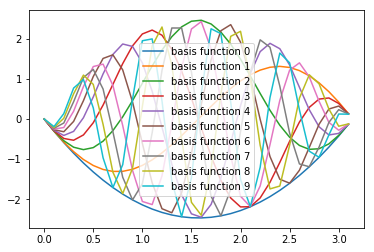4.5.28. Rigid Rotator Variational Solution#
4.5.28.1. Motivation#
We will see how we can solve the rigid rotator (or particle on a sphere) using the variational method.
4.5.28.2. Learning Goals:#
4.5.28.3. Coding Concepts:#
4.5.28.4. Background#
4.5.28.5. \(\Phi\):#
For \(\phi\) we simply use the analytic solution
\(-m^2 \Phi(\phi)= \frac{\partial^2}{\partial^2\phi} \Phi(\phi)\)
which is straightforward eigenvalue-eigenvector problem with solutions
\(\Phi(\phi) = A_me^{im\phi}\quad \mathrm{and}\quad A_{-m}e^{-im\phi}\).
Applying boundary conditions, \(\Phi(\phi+2\pi) = \Phi(\phi)\) yields the quantization
\(m=0,\pm 1, \pm 2, ...\)
Thus we can write
\(\Phi(\phi) = Ae^{im\phi} \quad m=0,\pm 1, \pm 2, ...\).
Normalization yields \(A=\frac{1}{\sqrt{2\pi}}\).
4.5.28.6. \(\Theta\):#
We start with the side of the equation with \(\theta\) dependence equal to \(m^2\):
\(m^2 = \frac{\sin\theta}{\Theta(\theta)}\frac{\partial}{\partial\theta}\left(\sin\theta\frac{\partial}{\partial\theta}\right)\Theta(\theta)+\beta\sin^2\theta\).
The goal now is to rearrange this to an eigenvalue equation. Start by substracting \(\beta\sin^2\theta\) from both sides:
\(m^2 - \beta\sin^2\theta = \frac{\sin\theta}{\Theta(\theta)}\frac{\partial}{\partial\theta}\left(\sin\theta\frac{\partial}{\partial\theta}\right)\Theta(\theta)\),
now multiply both sides of the equation by \(\Theta(\theta)\)
\(\left(m^2 - \beta\sin^2\theta\right)\Theta(\theta) = \sin\theta\frac{\partial}{\partial\theta}\left(\sin\theta\frac{\partial}{\partial\theta}\right)\Theta(\theta)\).
This resembles an eigenvalue equation except that \(\beta\) is multiplied by \(\sin^2\theta\). So we divide both sides of the equation by \(\sin^2\theta\) to yield:
\(\left(\frac{m^2}{\sin^2\theta} - \beta\right)\Theta(\theta) =\frac{1}{\sin\theta}\frac{\partial}{\partial\theta}\left(\sin\theta\frac{\partial}{\partial\theta}\right)\Theta(\theta)\)
We now recognize that \(m = 0, \pm 1, \pm 2, ...\) as dictated by the solutions above for \(\phi\). Thus we know something about \(m\) but nothing about \(\beta\). We will solve this for \(m=0\) and leave any other solution for excercise.
\(\Rightarrow \beta\Theta(\theta) =-\frac{1}{\sin\theta}\frac{\partial}{\partial\theta}\left(\sin\theta\frac{\partial}{\partial\theta}\right)\Theta(\theta)\)
This is an eigenvalue equation that we can apply the variational principle to. We must now devise a basis set that is defined over domain \(0 < \theta < \pi\) and the derivative of the functions must be zero at the boundaries (why?).
4.5.28.7. \(\cos(i\theta)\) basis#
We will use the general basis functions
Thus the trial wave function will be
and, in practice, this summation will be truncated at finite \(N\). We will start by using \(N=2\).
First, however, let’s look at what these basis functions look like over the domain \(0 \leq \theta \leq \pi\):
Show code cell source
# cos basis function in theta
def theta_basis(theta,i):
return np.cos(i*theta)
thetaVals=np.arange(0,np.pi,0.1)
for i in range(5):
label = "basis function " + str(i)
plt.plot(thetaVals,theta_basis(thetaVals,i),label=label)
plt.legend();
---------------------------------------------------------------------------
NameError Traceback (most recent call last)
Cell In[1], line 4
2 def theta_basis(theta,i):
3 return np.cos(i*theta)
----> 4 thetaVals=np.arange(0,np.pi,0.1)
5 for i in range(5):
6 label = "basis function " + str(i)
NameError: name 'np' is not defined
Show code cell source
# code to perform Variational principle solution to expansion of wavefunctions in a gaussian basis to K+V Hamiltonian in 1D
from scipy import integrate
import numpy as np
hbar = 1.0
r0 = 1.0
mu = 1.0
Hconst = -hbar**2/(2*mu*r0)
Hconst = 1.0
# overlap integrand
def overlap_integrand(theta,basis_function,i):
return basis_function(theta,i)**2*np.sin(theta)
# S integrand
def S_integrand(theta,basis_function,i,j):
return basis_function(theta,i)*basis_function(theta,j)*np.sin(theta)
# variational principle basis set solution for KE plus V (typically harmonic) - basis functions are guassians
def basis_rigid_rotator(N,basis_function,H_integrand,thetaVals=np.arange(0,np.pi,0.1)):
S = np.zeros((N,N),dtype=np.float64) # basis function overlap matrix
H = np.zeros((N,N),dtype=np.float64) # Hamiltonian matrix, Hij = <Si|H|Sj>
# normalize basis functions
norm = np.empty(N,dtype=float)
for i in range(N):
norm[i] = np.sqrt(integrate.quad(overlap_integrand,0,np.pi,args=(basis_function,i))[0])
# populate the basis function overlap, S, and Hamiltonian, H, matrices
for i in range(N):
for j in range(N):
normConst = (norm[i]*norm[j])**(-1)
# basis function overlap matrix element
S[i,j] = normConst*integrate.quad(S_integrand,0,np.pi,args=(basis_function,i,j))[0]
# Hamiltonian matrix element
H[i,j] = Hconst*normConst*integrate.quad(H_integrand,0,np.pi,args=(i,j))[0]
# symmetrize
#S[j,i] = S[i,j]
#H[j,i] = H[i,j]
print("S = ", S)
print("H = ", H)
# finalize the S^-1*H matrix
SinvH = np.dot(np.linalg.inv(S),H)
print("S^{-1}H = ", SinvH)
# compute eigenvalues and eigenvectors
H_eig_val, H_eig_vec = np.linalg.eig(SinvH)
# reorder these in ascending order of eigenvalues
idx = H_eig_val.argsort()
E = H_eig_val[idx]
H_eig_vec = H_eig_vec[:,idx]
nTheta = thetaVals.size
psi = np.zeros((nTheta,N),dtype=np.float64)
# generate psis from coefficients
for A in range(N):
for i in range(N):
wave = H_eig_vec[i,A]/norm[i]*basis_function(thetaVals,i)
psi[:,A] = psi[:,A] + wave
# normalize the wavefunctions
psi2 = np.power(psi[:,A],2)
normPsi = integrate.simps(psi2*np.sin(thetaVals),thetaVals)
psi[:,A] /= np.sqrt(normPsi)
return E, psi, thetaVals, S, H
# plot of some of the Legendre polynomials and variational wavefunctions
import numpy as np
import matplotlib.pyplot as plt
%matplotlib inline
from scipy.special import lpmv
colors = ['b', 'g', 'r', 'c', 'm', 'y', 'k']
def plot_rigid_rotator_wavefunctions(psi,theta,maxL=5,maxM=1):
x = np.arange(-1,1,0.01)
plt.figure(figsize=(12,12),dpi= 80, facecolor='w', edgecolor='k')
plt.tick_params(axis='both',labelsize=20)
plt.grid( which='major', axis='both', color='#808080', linestyle='--')
count = 0
for l in range(maxL):
for m in range(maxM):
label = "l=" + str(l) + ", m=" + str(m)
normLpmv = np.sqrt(integrate.simps(np.power(lpmv(m,l,x),2),x))
plt.plot(x,lpmv(m,l,x)/normLpmv,lw=4,color=colors[count%len(colors)],alpha=0.6,label=label)
label = "Variational l=" + str(l) + ", m=" + str(m)
plt.plot(np.cos(theta),psi[:,l],lw=2,color=colors[count%len(colors)],linestyle='--',label=label)
count += 1
plt.legend(fontsize=16)
plt.show
def plot_rigid_rotator_densities(psi,theta,maxL=5,maxM=1):
x = np.arange(-1,1,0.01)
plt.figure(figsize=(12,12),dpi= 80, facecolor='w', edgecolor='k')
plt.tick_params(axis='both',labelsize=20)
plt.grid( which='major', axis='both', color='#808080', linestyle='--')
count = 0
totalCount = maxL*maxM+1.0
for l in range(maxL):
for m in range(maxM):
label = "l=" + str(l) + ", m=" + str(m)
normLpmv = np.sqrt(integrate.simps(np.power(lpmv(m,l,x),2),x))
plt.plot(x,np.power(lpmv(m,l,x)/normLpmv,2),lw=4,color=colors[count%len(colors)],alpha=0.6,label=label)
label = "Variational l=" + str(l) + ", m=" + str(m)
plt.plot(np.cos(theta),np.power(psi[:,l],2),lw=2,color=colors[count%len(colors)],linestyle='--',label=label)
count += 1
plt.legend(fontsize=16)
plt.xlabel(r'cos($\theta$)',fontsize=20)
plt.ylabel("Density",fontsize=20)
plt.show
# cos basis function in theta
def cos_basis(theta,i):
return np.cos(i*theta)
# H integrand
def cos_basis_H_integrand(theta,i,j):
return j*np.cos(i*theta)*( np.cos(theta)*np.sin(j*theta) + j*np.sin(theta)*np.cos(j*theta) )
E, psi, theta, S, H = basis_rigid_rotator(2,cos_basis,cos_basis_H_integrand,thetaVals=np.arange(0,np.pi,0.01))
print("Energies:", E)
S = [[1.00000000e+00 7.08090944e-17]
[7.08090944e-17 1.00000000e+00]]
H = [[0.00000000e+00 1.41618189e-16]
[0.00000000e+00 2.00000000e+00]]
S^{-1}H = [[0. 0.]
[0. 2.]]
Energies: [0. 2.]
# cos basis function in theta
def cos_basis(theta,i):
return np.cos(i*theta)
# H integrand
def cos_basis_H_integrand(theta,i,j):
return j*np.cos(i*theta)*( np.cos(theta)*np.sin(j*theta) + j*np.sin(theta)*np.cos(j*theta) )
E, psi, theta, S, H = basis_rigid_rotator(20,cos_basis,cos_basis_H_integrand,thetaVals=np.arange(0,np.pi,0.01))
print("Energies:", E)
plot_rigid_rotator_densities(psi,theta,maxL=6)
Energies: [ 0. 2. 6. 12. 20. 30. 42. 56. 72. 90. 110. 132. 156. 182.
210. 240. 272. 306. 342. 380.]
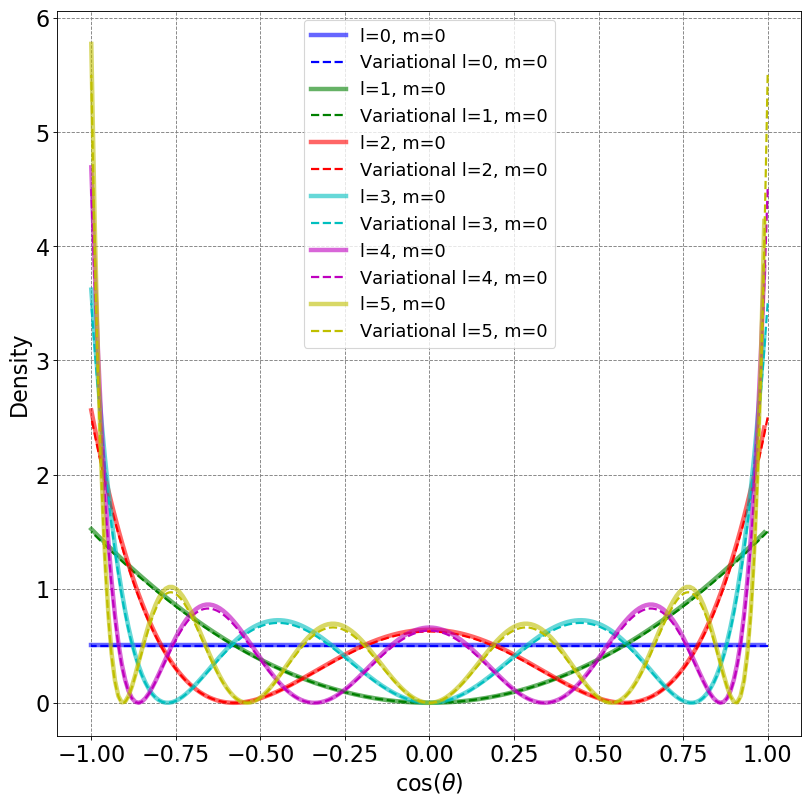
Determine selection rules using variational wavefunctions \(\langle J',m'|\mu_z|J,m\rangle = \mu_0N_{J,m}N_{J',m'}\int_0^{2\pi}d\phi e^{i(m-m')\phi}\int_{-1}^{1}dx \quad x P_{J'}^{|m'|}(x)P_J^{|m|}(x)\).
# integrate TDM as function of theta
integrate.simps(psi[:,0]*psi[:,1]*np.cos(theta)*np.sin(theta),theta)
0.5773499033920344
x = np.arange(-1,1,0.01)
norm0 = np.sqrt(integrate.simps(np.power(lpmv(0,0,x),2),x))
norm1 = np.sqrt(integrate.simps(np.power(lpmv(0,0,x),2),x))
print(integrate.simps(x*lpmv(0,4,x)*lpmv(0,3,x),x))
0.11781591697602778
print(theta)
[0. 0.01 0.02 0.03 0.04 0.05 0.06 0.07 0.08 0.09 0.1 0.11 0.12 0.13
0.14 0.15 0.16 0.17 0.18 0.19 0.2 0.21 0.22 0.23 0.24 0.25 0.26 0.27
0.28 0.29 0.3 0.31 0.32 0.33 0.34 0.35 0.36 0.37 0.38 0.39 0.4 0.41
0.42 0.43 0.44 0.45 0.46 0.47 0.48 0.49 0.5 0.51 0.52 0.53 0.54 0.55
0.56 0.57 0.58 0.59 0.6 0.61 0.62 0.63 0.64 0.65 0.66 0.67 0.68 0.69
0.7 0.71 0.72 0.73 0.74 0.75 0.76 0.77 0.78 0.79 0.8 0.81 0.82 0.83
0.84 0.85 0.86 0.87 0.88 0.89 0.9 0.91 0.92 0.93 0.94 0.95 0.96 0.97
0.98 0.99 1. 1.01 1.02 1.03 1.04 1.05 1.06 1.07 1.08 1.09 1.1 1.11
1.12 1.13 1.14 1.15 1.16 1.17 1.18 1.19 1.2 1.21 1.22 1.23 1.24 1.25
1.26 1.27 1.28 1.29 1.3 1.31 1.32 1.33 1.34 1.35 1.36 1.37 1.38 1.39
1.4 1.41 1.42 1.43 1.44 1.45 1.46 1.47 1.48 1.49 1.5 1.51 1.52 1.53
1.54 1.55 1.56 1.57 1.58 1.59 1.6 1.61 1.62 1.63 1.64 1.65 1.66 1.67
1.68 1.69 1.7 1.71 1.72 1.73 1.74 1.75 1.76 1.77 1.78 1.79 1.8 1.81
1.82 1.83 1.84 1.85 1.86 1.87 1.88 1.89 1.9 1.91 1.92 1.93 1.94 1.95
1.96 1.97 1.98 1.99 2. 2.01 2.02 2.03 2.04 2.05 2.06 2.07 2.08 2.09
2.1 2.11 2.12 2.13 2.14 2.15 2.16 2.17 2.18 2.19 2.2 2.21 2.22 2.23
2.24 2.25 2.26 2.27 2.28 2.29 2.3 2.31 2.32 2.33 2.34 2.35 2.36 2.37
2.38 2.39 2.4 2.41 2.42 2.43 2.44 2.45 2.46 2.47 2.48 2.49 2.5 2.51
2.52 2.53 2.54 2.55 2.56 2.57 2.58 2.59 2.6 2.61 2.62 2.63 2.64 2.65
2.66 2.67 2.68 2.69 2.7 2.71 2.72 2.73 2.74 2.75 2.76 2.77 2.78 2.79
2.8 2.81 2.82 2.83 2.84 2.85 2.86 2.87 2.88 2.89 2.9 2.91 2.92 2.93
2.94 2.95 2.96 2.97 2.98 2.99 3. 3.01 3.02 3.03 3.04 3.05 3.06 3.07
3.08 3.09 3.1 3.11 3.12 3.13 3.14]
# cos basis function in theta
def cos_pow_i_basis(theta,i):
return np.cos(theta)**i
thetaVals=np.arange(-0,np.pi,0.1)
for i in range(5):
label = "basis function " + str(i)
plt.plot(np.cos(thetaVals),cos_pow_i_basis(thetaVals,i),label=label)
plt.legend()
<matplotlib.legend.Legend at 0x1511a2e390>
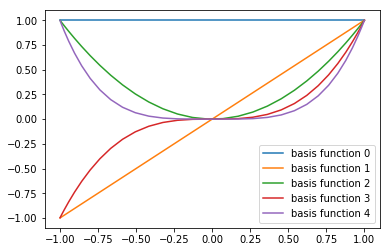
# H integrand
def cos_pow_i_H_integrand(theta,i,j):
cosTheta = np.cos(theta)
sinTheta = np.sin(theta)
return j*( 2*sinTheta*cosTheta**(i+j) - (j-1)*sinTheta**3*cosTheta**(i+j-2) )
E, psi, theta, S, H = basis_rigid_rotator(20,cos_pow_i_basis,cos_pow_i_H_integrand,thetaVals=np.arange(0,np.pi,0.01))
print(E)
plot_rigid_rotator_wavefunctions(psi,theta)
[ 0. 2.00007206 6.00000604 12.00000014 19.99991409
29.99941527 42.00029496 56.00009422 71.99957204 89.99861699
109.99974835 132.00224843 156.00151461 181.99883156 209.99829613
240.00007679 272.00026814 306.00023198 341.99079154 380.02703464]

E, psi, theta, S, H = basis_rigid_rotator(10,cos_pow_i_basis,cos_pow_i_H_integrand,thetaVals=np.arange(0,np.pi,0.01))
plot_rigid_rotator_densities(psi,theta)
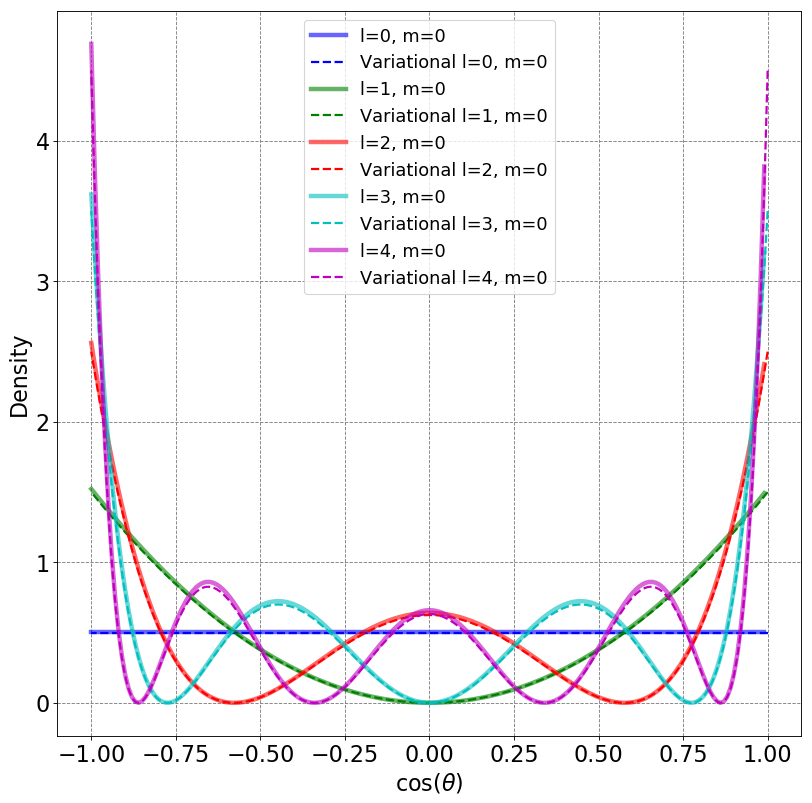
# polynomial basis functions in theta
def poly_basis(theta,i):
return (theta)**(i)*(theta-np.pi)**(i)
thetaVals=np.arange(-0,np.pi,0.1)
for i in range(10):
label = "basis function " + str(i)
plt.plot(thetaVals,poly_basis(thetaVals,i),label=label)
plt.legend(loc=2)
<matplotlib.legend.Legend at 0x7fbd886ce550>
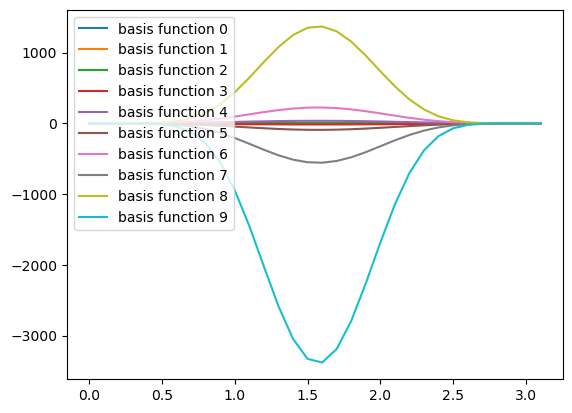
# H integrand
def poly_H_integrand(theta,i,j):
thetaMpi = theta - np.pi
return -j*theta**i*thetaMpi**i * (np.cos(theta) * (theta**(j-1)*thetaMpi**j + theta**j*thetaMpi**(j-1)) + np.sin(theta)*(2*j*theta**(j-1)*thetaMpi**(j-1)+(j-1)*(theta**(j-2)*thetaMpi**j+theta**j*thetaMpi**(j-2))))
E, psi, theta, S, H = basis_rigid_rotator(2,poly_basis,poly_H_integrand,thetaVals=np.arange(0,np.pi,0.01))
print(E)
plot_rigid_rotator_densities(psi,theta,maxL=2)
S = [[ 1. -0.96891319]
[-0.96891319 1. ]]
H = [[-0.00000000e+00 1.68972090e-16]
[ 0.00000000e+00 4.38792777e-01]]
S^{-1}H = [[0. 6.94611009]
[0. 7.16897049]]
[0. 7.16897049]
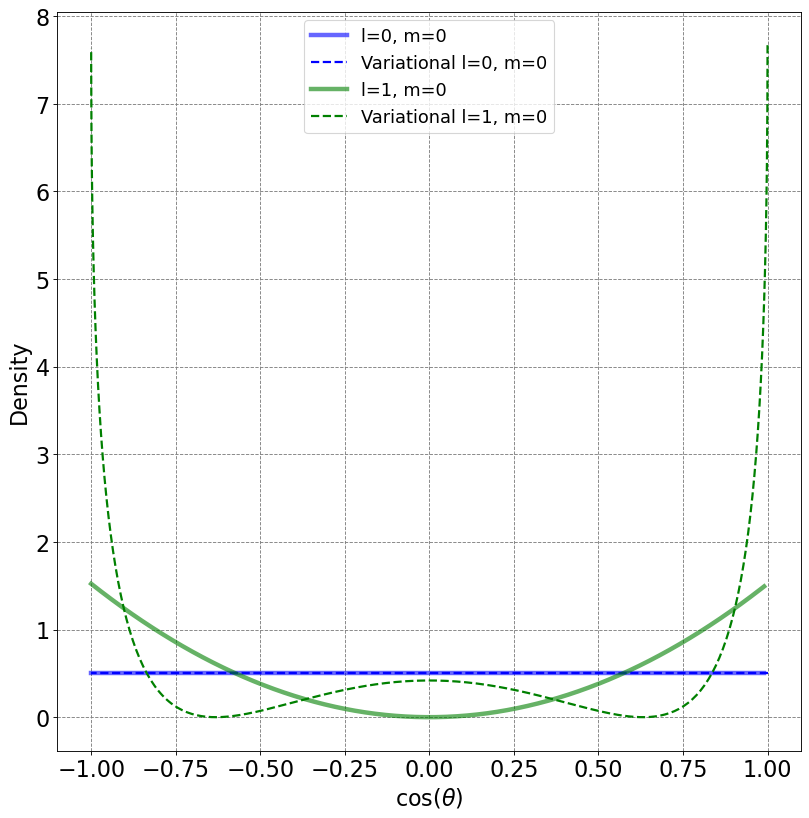
# polynomial basis functions in theta
def cos_poly_basis(theta,i):
return theta*(theta-np.pi)*np.cos(i*theta)
thetaVals=np.arange(-0,np.pi,0.1)
for i in range(10):
label = "basis function " + str(i)
plt.plot(thetaVals,cos_poly_basis(thetaVals,i),label=label)
plt.legend()
<matplotlib.legend.Legend at 0x108a5efd0>
